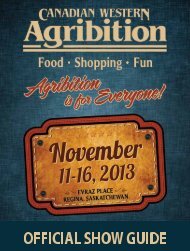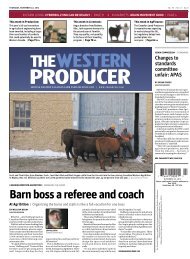Create successful ePaper yourself
Turn your PDF publications into a flip-book with our unique Google optimized e-Paper software.
78 DECEMBER 13, 2012 | WWW.PRODUCER.COM | THE WESTERN PRODUCER<br />
NEWS<br />
Six federal irrigation projects in Saskatchewan will be decommissioned if users are not interested in taking over operations. | FILE PHOTO<br />
FLOOD IRRIGATION PROJECTS | PRODUCER TAKEOVERS<br />
Irrigation project proposal in limbo<br />
No word from Ottawa | Farmers have not received answers to questions on finances or operations<br />
STORIES BY KAREN BRIERE<br />
REGINA BUREAU<br />
MOOSE JAW, Sask. — Southwestern<br />
Saskatchewan farmers who will<br />
take over federal irrigation works by<br />
2017 hope to know in January if their<br />
financial terms have been accepted.<br />
Darren Steinley, a member of the<br />
producer negotiation committee<br />
representing the six flood irrigation<br />
projects, said the producers submitted<br />
a proposal to Agriculture<br />
Canada in May but still haven’t heard<br />
back.<br />
He declined to say how much the<br />
producers want to help them maintain<br />
and operate the projects.<br />
“<strong>The</strong>y indicated they were willing<br />
to invest to divest, which means they<br />
were willing to give the producers<br />
some money to carry on with the<br />
projects,” Steinley said of the federal<br />
government.<br />
Ottawa said in 2007 it wanted users<br />
to take over the projects. If not, they<br />
would be decommissioned. It also<br />
said it would eventually sell its 33<br />
dams and water control structures in<br />
the province.<br />
About 250 producers irrigate 20,000<br />
acres through intensive flood irriga-<br />
BY BARBARA DUCKWORTH<br />
CALGARY BUREAU<br />
A series of educational videos will<br />
soon be available online for beef producers.<br />
<strong>The</strong> Beef Cattle Research Council<br />
has worked with the internet-based<br />
news service RealAgriculture to<br />
We’re pretty confident as<br />
producers that we can take the<br />
projects over and we can run<br />
them, and we can probably<br />
run them more efficiently and<br />
effectively than governments in<br />
the past have run them.<br />
DARREN STEINLEY<br />
PRODUCER NEGOTIATION COMMITTEE<br />
tion in the six projects. Steinley said<br />
the result is 60,000 tonnes of hay each<br />
year in the form of 100,000 round<br />
bales.<br />
<strong>The</strong>re are two projects near Val<br />
Marie and one each at Consul, Eastend,<br />
Maple Creek and Rush Lake.<br />
In 2009, four groups were already<br />
doing some of the work involved in<br />
operating the projects. During the<br />
last two years, a consultant has<br />
helped them plan for the takeover.<br />
Steinley said that process was useful<br />
in terms of getting the users talking<br />
and planning, but “we didn’t get<br />
any real financial answers or any<br />
clear understanding of how to run<br />
develop 30, 10-minute videos to introduce<br />
new techniques. <strong>The</strong>y will feature<br />
interviews with researchers, veterinarians<br />
and other industry experts.<br />
Council head Reynold Bergen said<br />
on one of the videos that research<br />
affects producers’ everyday lives,<br />
whether it is studying the impacts of<br />
antimicrobial resistance or animal<br />
the project.”<br />
<strong>The</strong> proposal is based on the costs<br />
the users determined, he said.<br />
“We’re pretty confident as producers<br />
that we can take the projects over<br />
and we can run them, and we can<br />
probably run them more efficiently<br />
and effectively than governments in<br />
the past have run them,” he said.<br />
Steinley said there are still issues<br />
that need to be clarified.<br />
<strong>The</strong> projects are supposed to be<br />
turned over in good working condition,<br />
and an engineer has assessed<br />
them and rated them from one to<br />
four — one being in poor condition<br />
and four being in good condition.<br />
“<strong>The</strong> AESB (Agriculture Canada’s<br />
agri-environmental services branch)<br />
has promised us that when we take<br />
over the projects in 2017, all structures<br />
will be at a three and four,” he<br />
said.<br />
However, a weir at Maple Creek that<br />
was destroyed during recent flooding<br />
will not be replaced. Users might get<br />
works in good condition, he added,<br />
but they might not get everything<br />
they are expecting.<br />
As well, there are seepage issues<br />
with one of the projects on the lower<br />
Frenchman River, which could dam-<br />
productivity. Slow, incremental<br />
improvements in feed efficiency have<br />
made it possible to produce more<br />
pounds of beef per cow.<br />
Three decades ago, 10 pounds of<br />
feed were needed for one lb. of weight<br />
gain, but modern animals produce<br />
one lb. of gain for every six lb. of feed.<br />
Darren Bevans, manager of Deseret<br />
age soil and result in improper irrigation,<br />
and the Rush Lake group has an<br />
outstanding concern about drainage<br />
into Reed Lake, where a landowner<br />
doesn’t want water to accumulate.<br />
Reed Lake is the natural drainage<br />
collection point for the area, and<br />
water from irrigation also ends up in<br />
the basin.<br />
“<strong>The</strong> province says we can put our<br />
water there, but we’d be more comfortable<br />
with a licence that says we<br />
can do that,” Steinley said.<br />
Other concerns include working<br />
with rural municipalities and what<br />
happens to the water if users don’t<br />
take over and the irrigation works<br />
aren’t used.<br />
He said the 10-year negotiation and<br />
divestiture process is too long for<br />
producers who typically make quick<br />
decisions based on what’s best for<br />
their operations<br />
“It’s tough to plan crop rotations,<br />
hay rotations, what you’re going to<br />
buy for land, how many more cows<br />
you’re going to buy, different things<br />
like that when you’re trying to plan<br />
for 10 years down the road.”<br />
Ottawa previously tried to sell its<br />
Saskatchewan infrastructure in 1961,<br />
1967, 1986 and 1994.<br />
Ranches, said on the video that his<br />
operation has been able to take new<br />
ideas and technology and fine tune<br />
them.<br />
For example, studies on the benefits<br />
of swath grazing showed this technique<br />
was a profitable way to winter<br />
cows.<br />
“It has helped us move light years<br />
RESEARCH | IRRIGATION<br />
Irrigated<br />
vegetable<br />
possibilities<br />
examined<br />
Consultant looks at valueadded<br />
opportunities in<br />
Saskatchewan vegetable<br />
acre expansion<br />
MOOSE JAW, Sask. — A study is<br />
underway to determine if Saskatche–<br />
wan is a good candidate for high volume<br />
vegetable production.<br />
<strong>The</strong> study, which is led by the Saskatchewan<br />
Irrigation Projects Association,<br />
will look at whether the<br />
province could supply more of its<br />
own produce and whether there is<br />
potential to supply others, said<br />
Judie Dyck, a Saskatoon-based<br />
consultant.<br />
She told the SIPA annual conference<br />
Dec. 4 that the study will determine<br />
how much land is available for<br />
vegetable production under irrigation,<br />
what type of crop rotation<br />
would be necessary and the role of<br />
Regina’s Global Transportation Hub<br />
(GTH) in transporting produce.<br />
Loblaw Co.’s western distribution<br />
centre, which ships produce throughout<br />
<strong>Western</strong> Canada, was the first<br />
tenant at the GTH.<br />
Dyck said Loblaw has indicated a<br />
willingness to work with local growers,<br />
and discussions have centred on<br />
prioritizing three to five crops.<br />
Saskatchewan irrigators already<br />
grow 8,500 acres of potatoes a year,<br />
half for the table market and half for<br />
seed.<br />
Pumpkins, green beans, beets,<br />
onions and corn are grown on another<br />
500 acres. As well, Hutterite colonies<br />
and market gardeners, mostly in<br />
the Lumsden-Craven area and near<br />
Saskatoon, sell from the farmgate.<br />
“We’re only producing 10 percent<br />
of what we consume, so we have an<br />
opportunity to provide at least what<br />
Saskatchewan needs,” Dyck told the<br />
conference.<br />
Statistics Canada has said fresh<br />
vegetable consumption is increasing<br />
to 165 pounds per person per year.<br />
Many people prefer to buy local but<br />
can’t if production isn’t sufficient.<br />
Dyck also said there are value added<br />
opportunities that the Prairies<br />
could capitalize on, such as canned<br />
borscht.<br />
“We have the land base and the<br />
water,” she said.<br />
“We need the skills, the people that<br />
want to get into the marketplace.”<br />
<strong>The</strong> study’s report is to be complete<br />
by December 2013.<br />
EDUCATION | BEEF SECTOR<br />
Beef industry experts share knowledge, research on Real Agriculture videos<br />
ahead rather than just trying it on our<br />
own,” he said.<br />
<strong>The</strong> videos in the Beef Research<br />
School program can be seen at www.<br />
BeefResearachSchool.com or www.<br />
BeefResearch.ca.<br />
Funding for the project came from<br />
the Alberta Livestock and Meat<br />
Agency and Agriculture Canada.








